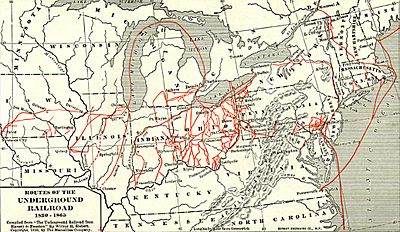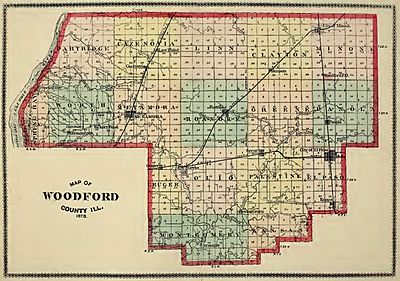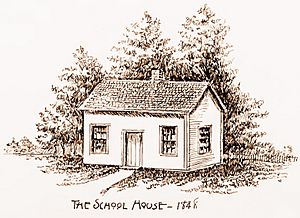Woodford County, Illinois facts for kids
Quick facts for kids
Woodford County
|
|
|---|---|
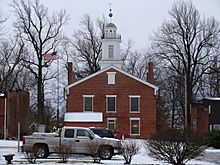
|
|
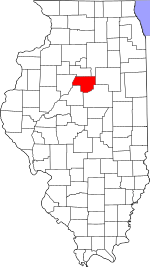
Location within the U.S. state of Illinois
|
|
 Illinois's location within the U.S. |
|
| Country | |
| State | |
| Founded | February 1841 |
| Named for | Woodford County, Kentucky |
| Seat | Eureka |
| Largest city | Eureka |
| Area | |
| • Total | 543 sq mi (1,410 km2) |
| • Land | 528 sq mi (1,370 km2) |
| • Water | 15 sq mi (40 km2) 2.7% |
| Population
(2010)
|
|
| • Total | 38,664 |
| • Estimate
(2018)
|
38,463 |
| • Density | 71.20/sq mi (27.492/km2) |
| Time zone | UTC−6 (Central) |
| • Summer (DST) | UTC−5 (CDT) |
| Congressional district | 18th |
Woodford County is a county located in the state of Illinois. The 2010 United States Census listed its population at 38,664. Its county seat is Eureka. Woodford County is part of the Peoria, IL, Metropolitan Statistical Area. Its name comes from General William Woodford, an officer of the American Revolutionary War who served at the brutal military encampment at Valley Forge, Pennsylvania.
Contents
History
Establishment
Woodford County is part of what was formerly the homelands of several Native American peoples, including the Potawatomi, the Meskwaki, and the Sauk peoples. It was located just south of the land of the Illiniwek. The western portion of the county in particular shows extensive archeological evidence of supporting extensive First Nations populations.
At the time of the American Revolutionary War, three competing American colonies — Massachusetts, Virginia, and Connecticut — each claimed part of what is today the state of Illinois. The matter was ultimately solved in 1778 when Virginia amalgamated lands in the region into a massive county called Illinois, borrowing the name of a native people. Indiana Territory was formed in 1800 with William Henry Harrison its first Governor; Illinois was part of it. It was not until 1809 that Illinois Territory was formally established as an official territory of the United States of America. Statehood followed in December 1818.
The first organized Anglo settlements in the region began to appear in today's Woodford County during the decade of the 1820s. First settlement in the county came at Spring Bay, with pioneers managing to select the same ground occupied by an ancient Indian burial site which ran north-and-south through the entire settlement. The precise location was chosen due to its proximity to the Illinois River.
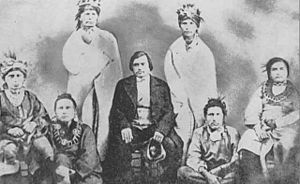
Writing in the 1870s, an early historian of Woodford County records that
"There were a few Indians in the county at the time of settlement by the whites, but the two races did not come into conflict to any extent. The advancing wave of civilization seemed to follow up the retreating wave of barbarism. The first settlers encountered a few Indians...and in 1832 were involved to some extent in the Black Hawk War, but the active operations were further north than Woodford County."
The current boundaries of the county were not those originally drawn; moreover, the names of various counties in the region changed frequently and irregularly during pioneer years. Consequently, one needs a smart phone or a scorecard: the Eastern portion of Woodford County was known variously as Edwards (1814–16), Crawford (1816–19), Clark (1819–21), and Fayette (1821-25) Counties, while the Western part of today's county was included in Madison (1814–17), Bond (1817–21), and Sangamon (1821–25) Counties.
In 1827 new lines were drawn and Tazewell County was established, including all of today's Woodford County within its boundaries. Permanent settlers began arriving from neighboring territories during the early 1830s. This led to the formal creation of Woodford County along its current boundaries in February 1841.
The County was named for Woodford County, Kentucky, which was in turn named after General William Woodford, who served with General George Washington at Valley Forge, Pennsylvania during the brutal winter of 1777-78.
The first post office in today's Woodford County was established in 1836 at Partridge township, named for local tribal leader Black Partridge. This was also the date of establishment of the first school in the county, a private school taught by Miss Betsy Page. The first public school followed shortly thereafter. The first Sunday school was established in 1837 in the home of Parker Morse in Cazenovia.
Pioneer life
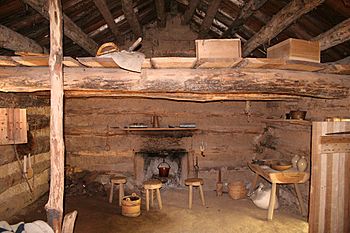
The first settlers of Woodford County occupied crude log cabins, with the cracks between the rough-hewed timber in the walls filled up with clay to help retain heat and block the wind. Windows, if they existed at all, were made of oiled papers, while doors and floors were constructed of rough boards split from trees and attached together with wooden pegs. Construction of the cabins was primitive, with the floor plan generally involving a single room heated with a fireplace.
Meat was frequently roasted on a spit and as many cabins were devoid of ovens, cornbread was generally baked directly on the fireplace coals. A common staple of pioneer life was waffles, baked from batter in a folding iron mold three or four feet long. Modern canning processes were unknown and the wintertime larder consisted primarily of bread and meat. Vegetables were consumed seasonally, with pumpkin, red peppers, corn, and venison dried for later use.
Clothing was self-manufactured, generally from linen made from homegrown flax. In addition, other heavier compound fabrics known as "linsey," made of linen or cotton with woolen filling, and "jeans," made of an even heavier material and dyed brown with walnut bark, were also used.
Prior to 1831 all preparation of wool had to be done by hand at home, with the raw fiber "carded" between pairs of thin, metal spiked boards about 4 inches wide and a foot long. The resulting rolls of wool were then spun into thread upon a spinning wheel and thereby prepared for the loom.
A sexual division of labor was practiced, with women engaged in home manufactures and food preparation while men were occupied with agriculture, hunting, and construction. Since a great percentage of the land of Woodford County was tillable, farming was far and away the most important occupation of the early settlers. Plowing was by means of wooden plows with iron shares; corn was planted by hand and covered using a hoe. Hay, often using wild rather than cultivated grass, was cut with a scythe and taken up with rakes and pitchforks.
With the advent of timber milling in the area, frame houses came into vogue. Settlers cooperated in construction, helping one another raise houses and barns. The latter could be 30 feet in length and width with walls perhaps 16 feet high. "It was heavy and dangerous work," one memoirist has recalled, "and the raising of a large barn required the united energies of a whole community." Other buildings commonly constructed included stables, corn-cribs, smokehouses, and ash-hoppers. Plank fences began to appear only in the 1850s.
Governance by the early settlers was not by secret ballot, but by voice vote.
Antebellum years
By the end of the 1840s, Woodford County had begun to be well settled by Americans, with the county's population topping the 5,000 mark. Those settling the state of Illinois were overwhelmingly opposed to the institution of slavery and with the passage of the Fugitive Slave Act of 1850, popular discontent grew and opponents began to engage in acts of resistance, hiding escaped slaves seeking liberation in Canada. One branch of the so-called underground railroad along which escaped slaves furtively avoided their potential captors ran directly through Woodford County.
The "stations" of the underground railroad were generally residences where escaping slaves could eat and sleep out of sight of their pursuers. These stations were located at convenient distances so that those escaping (and their "conductor" guides) could travel from one to the next in a single night.
The journey was dangerous. Wanted posters offering rewards of $50, $100, and sometimes more for specific runaway slaves were placed by slaveowners, attracting bounty hunters to a quest. Moreover, those assisting escaping slaves were themselves violators of the Fugitive Slave Law, subject to prosecution and punishment.
Local historian Roy L. Moore recalled:
"...There was bitter opposition to the enforcement of the fugitive slave law. This condition was not surprising, since the county had men, who were strong opponents of slavery and likewise men who would make any sacrifice to have the institution stamped out. Over this branch of the underground road many a run-away slave passed on his way to freedom. There was such a strong sentiment against the [slave] traffic that conductors and stations were found in sufficient number to carry on the work successfully."
Church deacons named Mr. Dutton and Parker Morse were credited by Moore as leaders of the local anti-slavery effort.
Early administrative structure
When it was first established in 1841, the county seat of Woodford County was placed in Versailles for a temporary two-year interval. Competition for the honor (and related business opportunities) was fierce leading up to the June 1843 decision of the county commissioners to tap Metamora (then known as Hanover) as the new legal center. A county courthouse was begun in Metamora in 1844 and a county jail completed in that same town in March 1852.
It was during the pre-Civil War years that Woodford County adopted system of subdivision into townships — a reform which was met with strong opposition on the part of some area residents. No fewer than four public elections were held between 1850 and 1854 before the township system was finally approved with the requisite majority of votes.
Following the division of the county into townships in the spring of 1855, the system of county government was likewise altered, with a county commission giving way to a new institution called the board of supervisors. Early county officers, including the sheriff, coroner, school commissioner, surveyor, and treasurer were elected to two year terms of office, later changed to four year terms.
Other claimants arose attempting to wrest the county seat from Metamora, including Eureka, El Paso, and Roanoke. El Paso was nearly awarded the seat in 1867, when it sent a local attorney to make an offer of $30,000 to the town of Metamora to move the county seat to them. A closely contested vote ended with the apparent result in favor of El Paso reversed by a bare 10 votes in a recount.
Another vote in 1869 rejected an appeal to move the county seat to Eureka. A dubious recount in a third election held in November 1873 again overturned an apparent result to move the Woodford County seat to Roanoke. A fourth election in 1884, again proposing relocation to Roanoke, failed miserably. It was only in 1894 when a final election provided a decisive majority in favor of moving the county seat to Eureka that Metamora lost its status as county seat.
An impressive new courthouse building was quickly constructed in Eureka, cementing that town's status as legal and governmental center of Woodford County.
Civil War years

By the time of the outbreak of the American Civil War early in 1861, the population of Woodford County had tripled from the previous decade, being pegged at 13,281 at the time of the outbreak of hostilities. Support for the cause of the Union was extremely strong throughout the county; by the end of the war far years later some 1,643 of the county's men served under the flag of the nation against the Confederate States of America — 12.4% of the entire population of Woodford County.
Calls for troops were translated into state quotas, which in Illinois was customarily apportioned to the various counties according to their population. Enlistment bonuses were paid. After 1862 when the number of volunteers ultimately failed to fulfill a state's enlistment quota, a draft was begun. Substitutes for those drafted could be sent, with prices paid by the draftee to his substitute generally ranging of $500 to $600, although prices of up to $1,000 were sometimes reportedly paid.
Woodford County's volunteers — and later on conscripts — were dispersed among a wide range of units, making a universal summary of their wartime experience impossible. There were, however, some units composed largely of residents of Woodford County, including Company G of the 17th Illinois Volunteer Infantry Regiment, mustered at Peoria May 25, 1861, and which fought at the bloody Battle of Shiloh in Hardin County, Tennessee in April 1862. Several Woodford County men were among the 130 members of the 17th Infantry killed and wounded in the two-day battle. This unit also participated in the last phase of the 1863 Siege of Vicksburg in Warren County, Mississippi, a protracted battle which ultimately led to the surrender of over 29,000 Confederate troops.
Another unit containing numerous Woodford County men was the 47th Illinois Volunteer Infantry Regiment, which contained a heavy concentration from the county in its Companies B and I. Mustered into service at Peoria on August 16, 1861, the unit lost 30 killed and 100 wounded in the Battle of Corinth, Mississippi, in October 1862. The unit also suffered heavy casualties in a May 1863 charge during the initial phase of the Vicksburg Campaign. After the fall of Vicksburg in July 1863, the unit spent the duration guarding railroad lines, being discharged in October of that year.
The 77th Illinois Volunteer Infantry Regiment was another unit with a substantial Woodford County contingent, these men being concentrated in Companies C, F, and H. Serving under Maj. Gen. Gordon Granger, the 77th Illinois Volunteers participated in the bloody initial phase of the Vicksburg Campaign, during which several days of futile Union attacks were launched before a protracted siege was made and won. After participating in the first Vicksburg battles, the 77th was part of the group of Union invaders marched to the east, where on May 14, 1863, they took part in the Battle of Jackson, Mississippi, leading to the fall of that city. This success was followed the next spring by a catastrophe, however. In April 1864, having marched into Louisiana towards Alexandria, the unit was isolated and crushed in a cavalry support operation at the Battle of Sabine Cross-roads. Some 176 officers and men of the 77th Illinois were killed, wounded, or captured, leaving only 125 members of the regiment fit for duty. The unit was finally mustered out in July 1865, having participated in 16 battles.
Woodford County men served in numbers in Company A, 86th Illinois Volunteer Infantry Regiment, suffering losses in Kentucky at the Battle of Perryville in October 1862 and ultimately participating in Sherman's March to the Sea. Others were concentrated in Companies D and E of the 108th Illinois Volunteer Infantry Regiment, in which 205 of the 214 fatalities suffered by the regiment were due to disease rather than combat, 134 of whom died in February and March 1863 alone.
Eureka College
A leading community institution of Woodford County for more than 150 years is Eureka College, a liberal arts school affiliated with the Christian Church (Disciples of Christ) and the alma mater of President Ronald Reagan.
Eureka College traces its roots back to the summer of 1848, when a young collegian named A.S. Fisher appeared in Walnut Grove (original name of Eureka) and expressed his interest in conducting a school that would teach language, science, mathematics, and philosophy. Fisher was employed to teach school for 10 months, with a number of local worthies, including many active in the Church of Christ, guaranteeing payment of his salary. This school was formally launched in September 1848 in a small frame building in Walnut Grove.
Owing to the presence of a charismatic local religious leader, the Church of Christ showed great growth during this period, adding 100 adherents in 1848, with other supporters in neighboring counties. Demand grew for transformation of the school to a seminary with a capacity to provide room and board for students from other localities, with instructional costs to be covered through collection of tuition. In September 1849, the school was rechristened Walnut Grove Seminary and relaunched with A.S. Fisher as principal, assisted by a young woman "of superior ability and tact as a teacher." Fisher would ultimately spend 38 years associated with the college which would emerge.
Yet another name change was in the offing, as in December 1849 the school was formally incorporated as Walnut Grove Academy. Money was collected for an expansion of the facility and a new two story building constructed.
The concept of the enterprise continued to expand and planning and fundraising began for expansion of the academy into a fully fledged college, with necessary buildings and a library. Appeals were made to the state Missionary Convention of the Church of Christ in 1851 and enthusiasm for establishment of a college within the church laity grew.
Geography
According to the U.S. Census Bureau, the county has a total area of 543 square miles (1,410 km2), of which 528 square miles (1,370 km2) is land and 15 square miles (39 km2) (2.7%) is water. The bulk of the county is prairie land, with some of the high bluffs originally covered with timber.
Climate and weather
| Weather chart for Eureka, Illinois | |||||||||||||||||||||||||||||||||||||||||||||||
|---|---|---|---|---|---|---|---|---|---|---|---|---|---|---|---|---|---|---|---|---|---|---|---|---|---|---|---|---|---|---|---|---|---|---|---|---|---|---|---|---|---|---|---|---|---|---|---|
| J | F | M | A | M | J | J | A | S | O | N | D | ||||||||||||||||||||||||||||||||||||
|
1.8
30
13
|
1.8
36
18
|
3.2
48
29
|
3.5
62
38
|
4.2
73
49
|
3.7
83
58
|
3.8
86
62
|
3.4
84
60
|
3.3
78
52
|
2.8
66
41
|
3.3
49
30
|
2.4
35
19
|
||||||||||||||||||||||||||||||||||||
| temperatures in °F precipitation totals in inches source: The Weather Channel |
|||||||||||||||||||||||||||||||||||||||||||||||
|
Metric conversion
|
|||||||||||||||||||||||||||||||||||||||||||||||
In recent years, average temperatures in the county seat of Eureka have ranged from a low of 13 °F (−11 °C) in January to a high of 86 °F (30 °C) in July, although a record low of −28 °F (−33 °C) was recorded in February 1905 and a record high of 111 °F (44 °C) was recorded in July 1936. Average monthly precipitation ranged from 1.75 inches (44 mm) in January to 4.20 inches (107 mm) in May.
Major highways
 Interstate 39
Interstate 39 Interstate 74
Interstate 74 U.S. Highway 24
U.S. Highway 24 U.S. Highway 51
U.S. Highway 51 U.S. Highway 150
U.S. Highway 150 Illinois Route 26
Illinois Route 26 Illinois Route 89
Illinois Route 89 Illinois Route 116
Illinois Route 116 Illinois Route 117
Illinois Route 117 Illinois Route 251
Illinois Route 251
Adjacent counties
- Marshall County (north)
- LaSalle County (northeast)
- Livingston County (east)
- McLean County (southeast)
- Tazewell County (southwest)
- Peoria County (west)
Demographics
| Historical population | |||
|---|---|---|---|
| Census | Pop. | %± | |
| 1850 | 4,415 | — | |
| 1860 | 13,282 | 200.8% | |
| 1870 | 18,956 | 42.7% | |
| 1880 | 21,620 | 14.1% | |
| 1890 | 21,429 | −0.9% | |
| 1900 | 21,822 | 1.8% | |
| 1910 | 20,506 | −6.0% | |
| 1920 | 19,340 | −5.7% | |
| 1930 | 18,792 | −2.8% | |
| 1940 | 19,124 | 1.8% | |
| 1950 | 21,335 | 11.6% | |
| 1960 | 24,579 | 15.2% | |
| 1970 | 28,012 | 14.0% | |
| 1980 | 33,320 | 18.9% | |
| 1990 | 32,653 | −2.0% | |
| 2000 | 35,469 | 8.6% | |
| 2010 | 38,664 | 9.0% | |
| 2018 (est.) | 38,463 | −0.5% | |
| US Decennial Census 1790-1960 1900-1990 1990-2000 2010-2013 |
|||
As of the 2010 United States Census, there were 38,664 people, 14,276 households, and 10,675 families residing in the county. The population density was 73.3 inhabitants per square mile (28.3/km2). There were 15,145 housing units at an average density of 28.7 per square mile (11.1/km2). The racial makeup of the county was 97.4% White, 0.6% Asian, 0.5% Black or African American, 0.2% American Indian, 0.3% from other races, and 1.1% from two or more races. Those of Hispanic or Latino origin made up 1.4% of the population. In terms of ancestry, 48.7% were German, 14.1% were Irish, 10.9% were English, and 8.8% were American.
Of the 14,276 households, 34.8% had children under the age of 18 living with them, 63.7% were married couples living together, 7.5% had a female householder with no husband present, 25.2% were non-families, and 21.8% of all households were made up of individuals. The average household size was 2.64 and the average family size was 3.07. The median age was 39.6 years.
The median income for a household in the county was $65,890 and the median income for a family was $75,601. Males had a median income of $55,297 versus $35,435 for females. The per capita income for the county was $29,475. About 4.9% of families and 7.0% of the population were below the poverty line, including 10.6% of those under age 18 and 6.3% of those age 65 or over.
Administrative Townships
Woodford County is divided into 17 administrative townships:
- Cazenovia Township
- Clayton Township
- Cruger Township
- El Paso Township
- Greene Township
- Kansas Township
- Linn Township
- Metamora Township
- Minonk Township
- Montgomery Township
- Olio Township
- Palestine Township
- Panola Township
- Partridge Township
- Roanoke Township
- Spring Bay Township
- Worth Township
Named Communities
Within the boundaries of the 17 administrative townships there are a number of named communities, which include the following.
Cities and towns
Villages with population under 1,000
Unincorporated communities
Education
High schools in Woodford County
- El Paso-Gridley High School (El Paso)
- Eureka High School (Eureka)
- Fieldcrest High School (Minonk)
- Lowpoint-Washburn High School (Washburn)
- Metamora Township High School (Metamora)
- Roanoke-Benson High School (Roanoke)
Since 1949 Eureka has been a part of the Congerville-Eureka-Goodfield Community Unit School District 140. The district's coverage area totals 113 square miles. El Paso is part of the El Paso-Gridley Community Unit School District 11.
Notable people of Woodford County
- Donald Attig (b. 1936), boat designer and yachtsman, graduated from Eureka College
- Emik Avakian (1923-2013), inventor and owner of numerous patents, graduated from Eureka College in 1948
- Emma Smith DeVoe (1848-1927), suffragist and political activist, taught at Eureka College
- J. Frank Duryea (1869-1967), a co-inventor of the gas-powered automobile, born in Washburn
- Frank Frantz (1872-1941), Rough Rider and the final Governor of Oklahoma Territory, attended Eureka College for two years in the 1880s
- Glen Gray (1900-1963), jazz saxophonist and orchestra leader, born in Roanoke, graduated from Roanoke High School (1917)0
- Oliver Perry Hay (1846-1930), professor and expert on vertebrate paleontology, graduated from Eureka College (1870).
- John S. Kyser (1900-1975), President of Northwestern State University from 1954 to 1967, born in El Paso
- Dan McCoy (b. 1978), comedian and television writer, graduate of Eureka High School (1996)
- Ralph "Mac" McKinzie (1894-1990) coached football at Eureka College for 17 seasons
- Mary Frances Winston Newson (1869-1959), mathematician and academic, taught at Eureka College
- William A. Poynter (1848-1909), 10th Governor of Nebraska, born in Eureka, graduated from Eureka College (1867)
- Neil Reagan (1908-1996), advertising executive and brother of Ronald Reagan, graduated from Eureka College (1933)
- Ronald Reagan (1911-2004), 40th President of the United States, graduated from Eureka College (1932)
- Junius P. Rodriguez (b. 1957), historian, Eureka College professor (1992– )
- Fulton J. Sheen (1895-1979), Catholic archbishop and televangelist, born in El Paso
- Andy Studebaker (b. 1985) NFL linebacker for the Indianapolis Colts, Eureka High School graduate (2004)
- Caleb TerBush (b. 1990), collegiate football quarterback at Purdue University, Metamora Township High School graduate
- Ben Zobrist (b. 1981), All-Star Major League Baseball infielder for the Oakland Athletics, born and raised in Eureka
See also
 In Spanish: Condado de Woodford (Illinois) para niños
In Spanish: Condado de Woodford (Illinois) para niños


